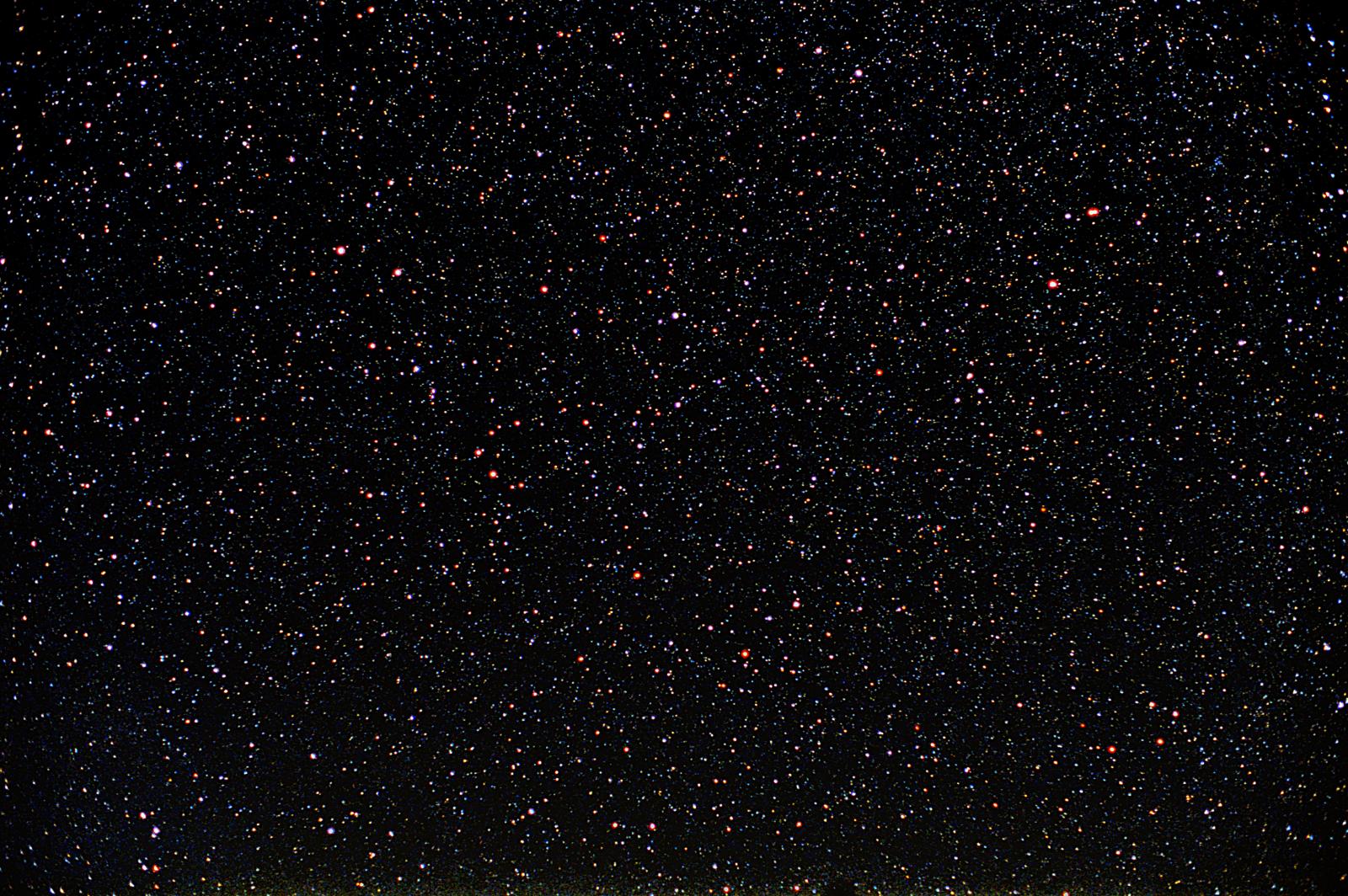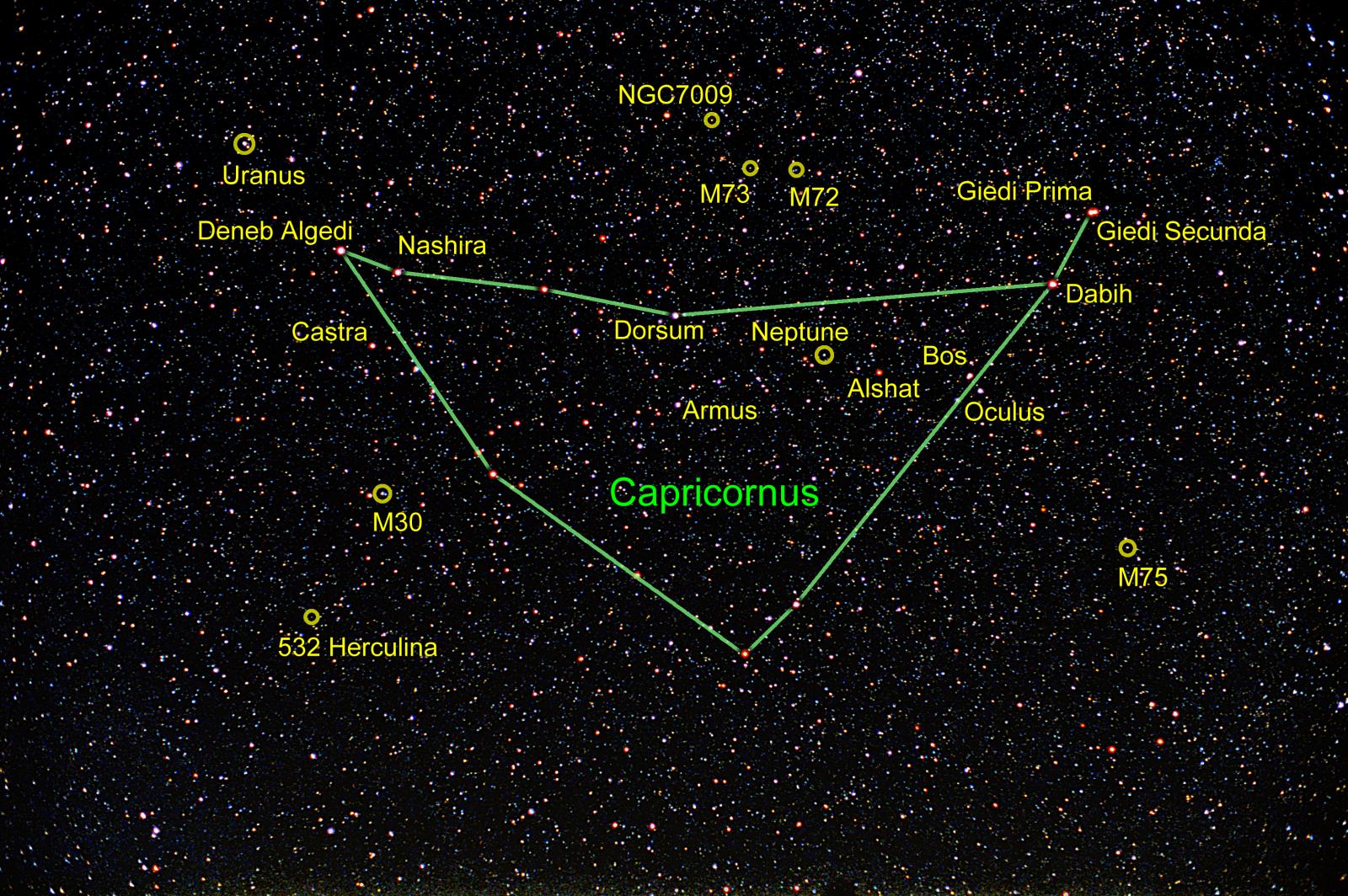Capricornus: The Sea Goat
| Object: | Capricornus |
| Location: | Savoy, MA |
| Observer: | Roland Roberts |
| Time: | 8 Aug 2002 |
| Camera: | Pentax K1000, 50 mm f/1.4 lens |
| Film: | Kodak Elite Chrome II, ISO 200 |
| Exposure: | 30 minutes at f/2.8 |
Capricornus lies low in the southern sky as seen from the mid-northern latitudes. It is most easily visible in late-summer (depending on how late you like to stay up, you can see it in early summer). Like most areas away from the Milky Way, Capricornus looks relatively bare. Only one Messier object lies in Capricornus.Capricornus looks to me more like a big “V” or even an open mouth than a sea-goat, but I don’t get to name constellations… At the time this photograph was taken, two planets and several asteroids were visible in the constellation of Capricornus, although only one of the asteroids was bright enough to show up unambiguously in this photo and even then, only when viewing it at the 800-pixel wide size or larger. Uranus is/was a (marginally) naked eye object, provided you know where to look. Neptune requires at least binoculars. Neither are very impressive. However, they can be distinguished from stars using a telescope, something which is true of all the planets except Pluto. Labeled in the picture are the following objects:
- Planets (2): Uranus and Neptune.
- Asteroids (1): 532 Herculina, which unknown to me at the time, was at its brightest for the year at magnitude 10.2. You can find orbital elements for 532 Herculina at Asteroids Dynamic Site web site. David Richards has a couple of frames from early 2000 showing the movement of this asteroid over a 24-hour period. Herculina is a main-belt asteroid.
- Globular Clusters (3): M72, M75, and M30.
- Open Clusters (1): M73.
- Planetary Nebulae (1): NGC 7009.
- Stars (2): Giedi Prima, Giedi Secunda, Dabih, Oculus, Nashira, Bos, Armus, and Dorsum, Castra, Deneb Algedi, and Alshat.
With the exception of M30, all the Messier and NGC object are actually part of Aquarius.
Resources:
Search
.Archives
- May 2025 (3)
- October 2024 (1)
- May 2024 (2)
- April 2024 (3)
- September 2022 (5)
- April 2022 (1)
- January 2022 (3)
- December 2021 (4)
- September 2021 (3)
- July 2021 (1)
- January 2021 (1)
- November 2020 (2)
- October 2020 (2)
- September 2020 (2)
- August 2020 (5)
- July 2020 (1)
- November 2019 (2)
- September 2019 (1)
- August 2019 (2)
- September 2017 (1)
- August 2017 (1)
- September 2015 (3)
- August 2015 (2)
- June 2015 (5)
- May 2015 (3)
- May 2013 (2)
- January 2013 (1)
- December 2012 (2)
- September 2012 (1)
- June 2012 (1)
- May 2012 (1)
- October 2011 (2)
- September 2011 (2)
- April 2011 (2)
- March 2011 (10)
- January 2011 (8)
- November 2010 (2)
- October 2010 (1)
- September 2010 (3)
- August 2010 (2)
- July 2010 (1)
- June 2010 (1)
- April 2010 (3)
- February 2010 (3)
- January 2010 (3)
- December 2009 (6)
- November 2009 (3)
- October 2009 (7)
- September 2009 (8)
- August 2009 (4)
- July 2009 (1)
- June 2009 (2)
- May 2009 (2)
- April 2009 (7)
- March 2009 (1)
- February 2009 (6)
- January 2009 (4)
- December 2008 (4)
- November 2008 (3)
- October 2008 (11)
- September 2008 (4)
- August 2008 (5)
- July 2008 (5)
- June 2008 (2)
- April 2008 (4)
- March 2008 (18)
- February 2008 (9)
- November 2007 (1)
- October 2007 (3)
- July 2007 (3)
- April 2007 (1)
- March 2007 (6)
- February 2007 (3)
- December 2006 (3)
- October 2006 (4)
- September 2006 (1)
- July 2006 (5)
- May 2006 (10)
- April 2006 (9)


